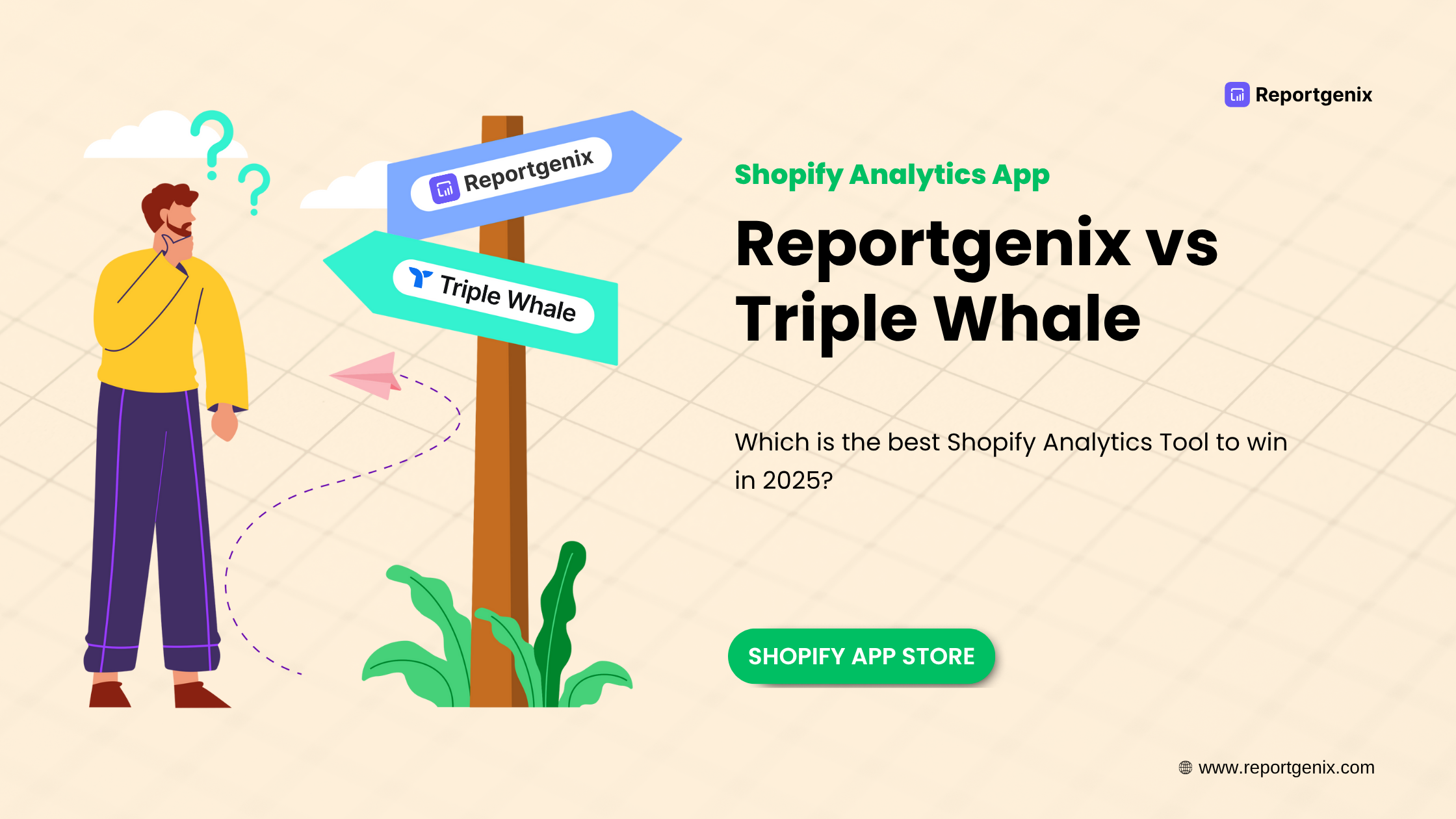Running a successful Shopify brand today means keeping track of a lot more than just sales. You need to know what’s driving profit, where your ad spend is going, which products are working, and how your customer lifetime value is shaping up. And Shopify’s default analytics? They don’t cut it.
That’s where tools like Reportgenix and Triple Whale come in. Both platforms aim to give you a clearer picture of your business, but approach it differently. Choosing between tools like Triple Whale and Reportgenix can be tricky, especially when there are many Shopify analytics alternatives worth exploring.
In this article, we’ll compare these two popular Shopify analytics tools. You’ll get a breakdown of their features, AI capabilities, pricing, integrations, and who each platform is best suited for.
Let’s help you decide which analytics tool, between Reportgenix vs Triple Whale, fits your brand best.
Reportgenix vs Triple Whale: At a Glance
Need a quick summary? Here’s how Reportgenix and Triple Whale compare across key areas:
| Feature | Reportgenix | Triple Whale |
| Pricing | – Free plan available- Paid plans scale with usage | – Starts at $149/month- Premium plans up to $449/month |
| Features | – Profit & tax analytics- SKU-level insights- Custom dashboards- Genix AI assistant- Scheduled reports | – Ad attribution- Triple Pixel & post-purchase surveys- LTV and CAC insights- Moby AI assistant |
| Integrations | – Shopify- GA4- Facebook Pixel- Slack | – Shopify- Meta, Google Ads, TikTok- Klaviyo, Yotpo, Recharge |
| Customer Support | – Email & Slack alerts- Helpful for accounting & operations teams | – Fast support for scaling DTC brands- Highly rated by marketing teams |
| Ease of Use | – Simple, clean UI- Easy setup for non-technical users | – Visual, but steeper learning curve- More complex setup for full value |
| Customer Reviews | 4.7/5 on G2 | 4.7/5 on G2 |
| Storage & Exports | – Export to CSV, Excel, PNG, SVG- Auto-scheduled reports | – Cloud dashboards only- No offline exports |
| Analytics Focus | – Post-sale performance- Profit & payout tracking | – Pre-sale attribution- Campaign and creative insights |
| AI Features | – Genix AI: business-focused Q&A reporting | – Moby AI: anomaly detection, trend forecasting |
| Best For | Small to mid-sized Shopify stores focused on profit clarity | Scaling DTC brands focused on ad performance and attribution |

What is Reportgenix?
Reportgenix is an e-commerce analytics platform built specifically for Shopify brands that care about profit, not just revenue.
It gives store owners deep insights into sales, product-level performance, tax obligations, payouts, etc. What sets it apart is Genix AI—its built-in assistant that helps you create reports, visualize data, and get instant answers to complex business questions.
It’s designed for operators, accountants, and marketers who need accurate reporting without wasting hours exporting spreadsheets or building dashboards from scratch. Reportgenix is also compared favorably in our Reportgenix vs Report Pundit breakdown, which covers other Shopify-native report tools.
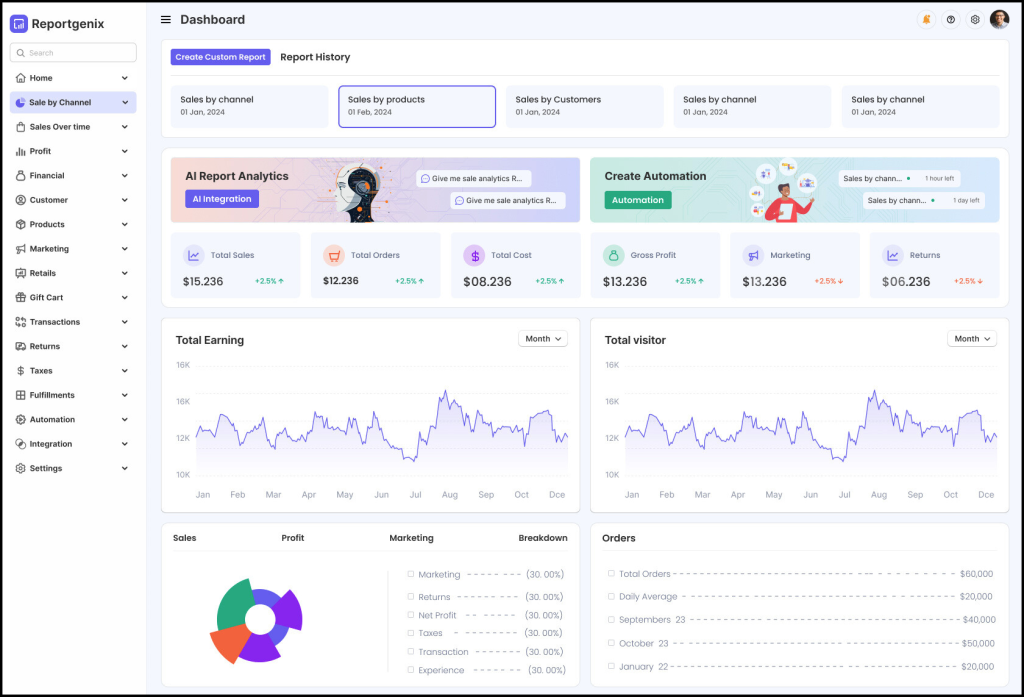
Reportgenix Key Features
- Custom Reports
Reportgenix gives you the power to build reports that fit your workflow. Whether you want a detailed profit/loss view, a breakdown of your best-selling products, or tax-ready summaries, you can create dashboards tailored to your needs.
You can drag and drop widgets, filter by product or region, and design visualizations that match your team’s thinking.
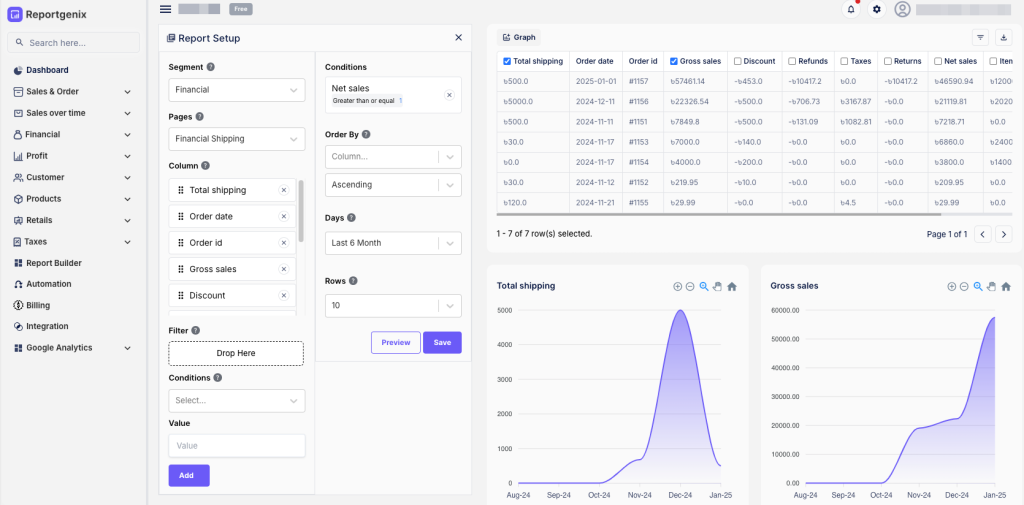
- Genix AI Assistant
Don’t want to build reports manually? Just ask Genix.
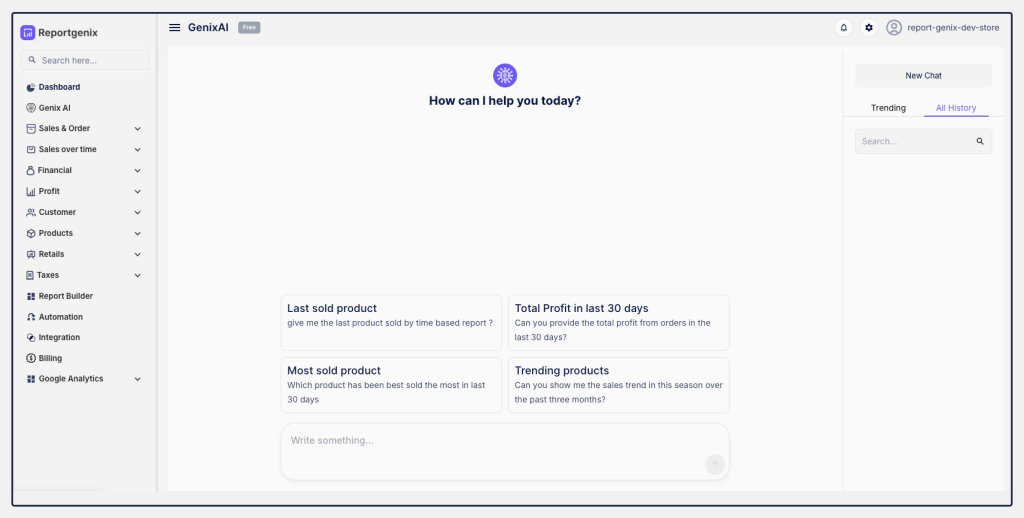
This AI assistant lets you type natural-language queries like:
- “What were my top 10 profitable products last month?”
- “Show me refund trends by product.”
- “Compare revenue between my US and UK stores.”
You get visual, ready-to-use answers—no technical skills required.
- Scheduled Reporting
You can set up automated reports to be sent to your team daily, weekly, or monthly. Push updates directly to Slack, email, or export formats like CSV, Excel, or SVG.
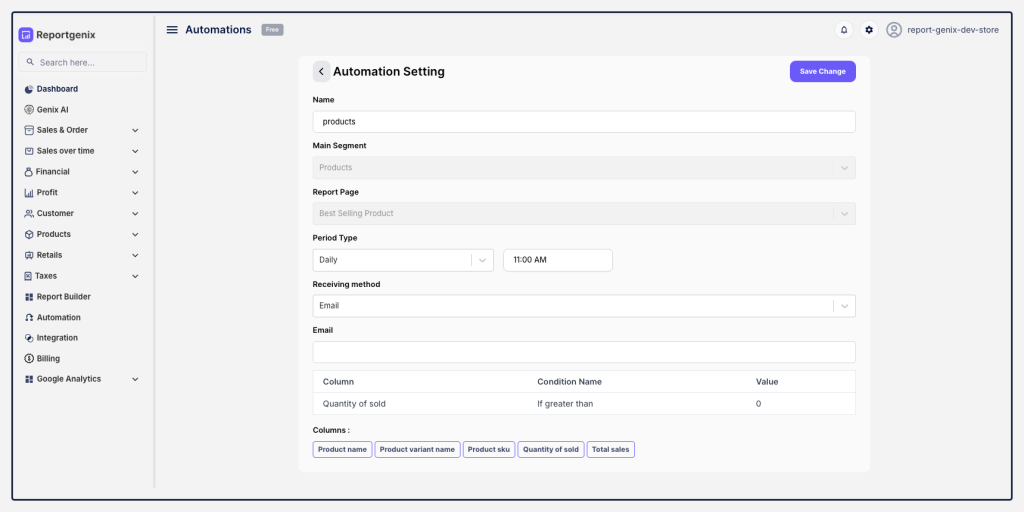
This feature is helpful for founders and managers who want to stay in the loop without logging in daily.
- Product Analytics
Reportgenix drills deep into each product’s financial performance. See how much you earn after refunds, discounts, shipping, and COGS.

- Multi-Currency Support
If you run international stores, Reportgenix converts sales into your preferred currency using live rates. This helps you analyze global profits more accurately.
- Integration
Setup is quick. Connect your Shopify store, and you’re ready to go. It also syncs with Slack.
What is Triple Whale?
Triple Whale is a popular ecommerce analytics platform designed for DTC brands. If you spend thousands a month on Meta, Google, or TikTok ads, this tool helps you understand whether your investment is paying off.
At its core, Triple Whale is a marketing attribution and performance platform. It helps you track customer journeys, see return on ad spend (ROAS), analyze creative performance, and forecast future revenue.
It’s popular among DTC brands that care about LTV, CAC, blended ROAS, and influencer ROI.
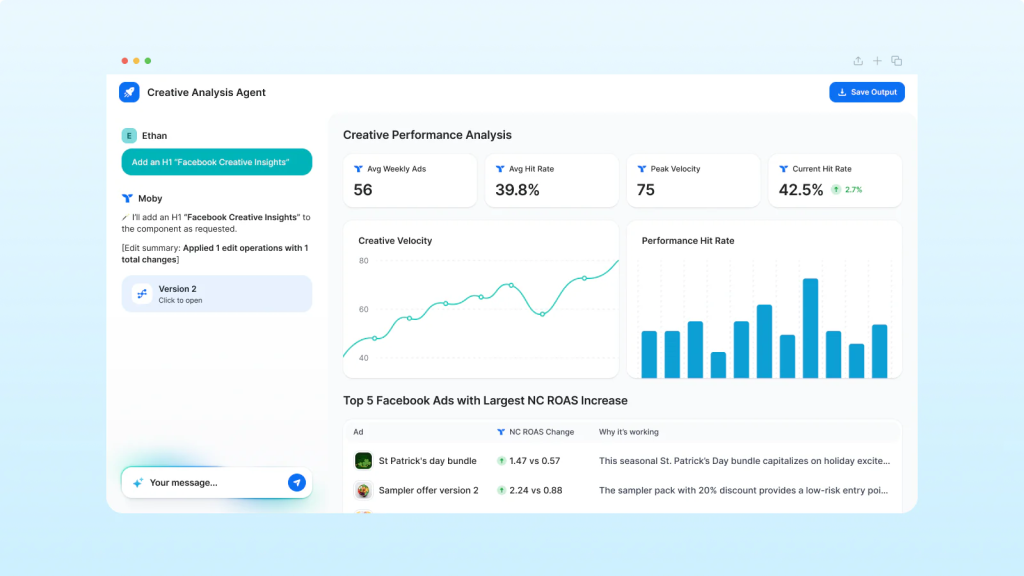
Triple Whale Key Features
- Marketing Attribution
Triple Whale connects all your marketing data—from Shopify, Meta Ads, Google Ads, TikTok, and more—and attributes sales back to the source.
Its proprietary tool, Triple Pixel, helps track users across sessions, platforms, and devices—even in a post-iOS14 world.

- Customer Journeys
You can see every step your customer took before they bought: the first ad click, the email opened, the final conversion. This is incredibly useful for optimizing your funnels and allocating ad budgets more effectively.
- Moby AI Assistant
Triple Whale’s AI assistant detects anomalies in your data, flags unusual performance changes, and provides revenue forecasts. It’s designed to help you make smarter, faster decisions without manually checking each channel.

- Creative Performance Tracking
Triple Whale doesn’t just tell you which ad worked. It tells you why it worked. You can compare thumbnails, copy, formats, and even timing across campaigns to optimize creatives that drive conversions.
- Post-Purchase Surveys
Want to know what influenced your buyer? Triple Whale’s post-purchase surveys collect zero-party data to improve attribution accuracy.
- LTV & Cohort Tracking
Triple Whale breaks down your customers by acquisition channel, purchase behavior, and predicted lifetime value. You can build more brilliant retention campaigns and adjust your CAC targets based on real insights.

Reportgenix vs Triple Whale: Feature-by-Feature
When choosing between Reportgenix and Triple Whale, it’s not just about picking a better analytics tool—it’s about choosing the right fit for your business goals. One excels at financial clarity, while the other is built for ad optimization. Below, we go deeper into how these tools compare across key dimensions.
1. Custom Reporting
Reportgenix prioritizes customization. You can build reports from the ground up using drag-and-drop elements and visual widgets. You can filter by product, country, date range, or order type to get granular insights. This solution is ideal for e-commerce operators who need flexibility and control over how they view business performance.
Triple Whale, in contrast, offers pre-designed dashboards focused on marketing KPIs. These are visually rich and highly optimized for tracking ROAS, CAC, and LTV, but offer limited control over layout or data types. It works well for marketing teams who want actionable insights without tweaking dashboard structures.
2. Attribution and Tracking
Triple Whale leads this category with its proprietary tracking pixel—Triple Pixel—which works across web platforms and mobile devices. Even in a post-iOS14 world, it captures attribution with high accuracy. Add in post-purchase surveys to get a clearer picture of which ads are converting and why.
Reportgenix doesn’t focus on attribution. Instead, it kicks in after the transaction, giving insights into what those conversions earned you. It’s less about where traffic came from and more about what it delivered regarding net profit.
3. AI Capabilities
Genix AI in Reportgenix is designed for business operations. You can ask it direct, simple questions like “What are my best-selling items this quarter?” or “Show me products with high return rates.” It’s excellent for surfacing insights buried in complex datasets.
Moby AI, Triple Whale’s assistant, is tuned for marketers. It provides predictive alerts, identifies data anomalies, and forecasts trends. You can act fast on unexpected changes in CAC, ad performance, or campaign saturation. It’s more proactive than reactive.
4. Dashboard Flexibility
Reportgenix wins on customization. Users can create a workspace that suits their workflow, finance structure, or reporting obligations. From margin breakdowns to regional sales comparisons, you can visualize exactly what matters to your team.
Triple Whale offers sleek, fast-loading dashboards with a strong marketing slant. They’re easy to navigate and great for at-a-glance decision-making. But if you need to customize something beyond what’s provided out of the box, you’re limited in how far you can go.
5. Product Insights
Reportgenix breaks down performance at the SKU level. It helps you understand which products are profitable after accounting for shipping, discounts, COGS, and returns. It is perfect for merchandising, supply chain, or product teams that want clear financial feedback.
Triple Whale focuses more on how customers interact with products through marketing. It tracks clicks, views, and conversion paths, but lacks accurate profitability data by item. That’s fine if you’re making marketing decisions—not so much if you’re managing inventory or cash flow.
6. Financial Reporting
Reportgenix excels here. It generates real-time profit and loss statements, tax-ready summaries, and payout reconciliations. It’s designed for business owners and finance teams who need accurate, audit-ready data they can trust.
Triple Whale gives high-level financial overviews linked to marketing campaigns but doesn’t go deep into accounting. If you’re looking for tools to reconcile Shopify payouts or calculate net margins, you’ll need another solution alongside it.
7. Integrations
Triple Whale boasts a broad integration ecosystem. It syncs with Meta Ads, Google Ads, TikTok, Klaviyo, Postscript, Recharge, and more—ideal for full-stack marketers running multi-channel campaigns.
Reportgenix is more streamlined. It integrates directly with Shopify, GA4, Meta Pixel, and Slack. These core connections are enough for analytics and reporting, but don’t cover the entire marketing stack.
8. Ease of Use
Reportgenix is built with simplicity in mind. The interface is intuitive, the AI assistant reduces setup time, and automation options save hours. It’s easy for solo founders, finance leads, or ecommerce managers to start using it immediately.
Triple Whale is also user-friendly but leans more toward data-savvy marketers. With more options comes more complexity. Teams may need onboarding to utilize the advanced marketing features fully.
9. Team Collaboration
Reportgenix allows sharing reports via Slack or email, keeping everyone aligned on KPIs. You can assign reporting cadences, send visual exports, and tag team members for follow-up.
Triple Whale emphasizes cross-functional collaboration between marketing and leadership. It centralizes campaign insights so everyone, from CMO to media buyers, can stay in sync. It fits the bill if you manage multiple stakeholders in a marketing-heavy operation.
10. Scalability
Reportgenix scales with you. As you grow, you can unlock more advanced features, integrations, and user permissions. It’s priced for accessibility but doesn’t compromise on depth.
Triple Whale is built for fast-scaling DTC brands. Its pricing reflects that. You’ll get maximum value if you run 6–7 figure ad budgets and need detailed attribution to sustain growth.
Pricing Breakdown
Reportgenix
- Free Plan: Great for small stores starting out
- Paid Plans: Scaled by usage and features—accessible for most small to mid-sized teams. The basic plan is just $4.9/month.
Triple Whale
- Growth Plan: Starts at $149/month
- Pro Plan: Up to $449/month
- Premium pricing, but designed for high-ROI brands who rely on attribution
Value Verdict: Reportgenix offers more bang for your buck if you’re tracking performance, not spending five figures on ads.
Triple Whale justifies its price for ad-heavy brands that need attribution clarity. If you’re deciding based on pricing and flexibility, make sure to check out our Reportgenix pricing page for the latest plans.
Curious how Reportgenix compares with other platforms beyond Triple Whale? See our Reportgenix vs Report Pundit comparison for deeper insights.
Final Verdict: Which Tool Should You Choose?
Choose Reportgenix if:
- You want clarity on profit, product margins, and financials
- You need tax and payout reporting
- You’re a small to mid-size Shopify store
Choose Triple Whale if:
- Your business runs on ads and attribution
- You want to understand customer journeys in detail
- You’re a scaling DTC brand with complex marketing needs
For most Shopify merchants who need powerful analytics without a steep learning curve or price tag, Reportgenix hits the sweet spot. It focuses on helping you understand what matters—profit.
Unless attribution is your biggest challenge, Reportgenix is the smarter first step if choosing between Reportgenix vs Triple Whale.
Conclusion
Both Reportgenix and Triple Whale offer powerful analytics but serve very different purposes.
If you need clarity on your store’s financial health—profit margins, tax obligations, and real product-level insights—Reportgenix is the clear choice. It’s intuitive, AI-powered, and built for operators who care about the bottom line.
Triple Whale gives you the attribution data you need to scale smartly if you’re running a large-scale marketing operation with heavy ad spend. From customer journeys to creative insights, it helps marketers track every dollar.
The best choice between Reportgenix vs Triple Whale depends on your current business focus. However, Reportgenix balances power, simplicity, and value for most growing Shopify brands.
FAQs
1. What is the difference between Reportgenix and Triple Whale?
Reportgenix focuses on post-sale analytics, such as profit, taxes, and product performance. Triple Whale specializes in ad attribution and marketing insights.
2. Is Triple Whale suitable for small Shopify stores?
It’s more suitable for high-growth brands with a large ad budget. Smaller stores may find it expensive and overly complex.
3. Can Reportgenix track ad performance?
No. Reportgenix tracks profits, returns, and payouts but doesn’t provide marketing attribution like ROAS or CAC.
4. Which tool is better for financial reporting?
Reportgenix is better for financial clarity. It provides P&L statements, tax summaries, and payout reconciliation.
5. Do both tools integrate with Shopify?
Yes. Both Reportgenix and Triple Whale integrate natively with Shopify.
6. Is Reportgenix a better alternative to Triple Whale?
It depends on your needs. Reportgenix is ideal for Shopify store owners looking for affordable, customizable reports with AI support. Read the full comparison.
7. What analytics features does Triple Whale lack?
Triple Whale offers great attribution, but lacks customizable exports and advanced AI features found in tools like Reportgenix.
